|
Monday, February 11, 2008
Progress Notes
In weeks past I have featured the biographies of some of the better known Miller County
physicians of the past. On one occasion, I also made reference to the offerings of some
medical practitioners who offered products in which the efficacy and helpfulness might
have been questioned. But the truth is, a century or so ago when roads were poor and
travel was by horseback or carriage, most rural people lived too far away from town to see
a doctor very often, especially for emergencies. So home and folk remedies were the usual
and sometimes only option when family members became ill or were injured. Sometimes, folks
would have a copy of Dr. Chase's Recipes which not only covered all known diseases of farm animals but also humans.
My father's family had a copy of the 1906 edition of Chase's Recipes which I now
have in my possession. It
makes for very interesting reading and really in some cases an occasional
"chestnut" is offered which is of more than a little benefit.
Two previous Progress Notes (September 2
and September 10, 2007) include a wonderful
discussion of the way medicine was practiced in rural Miller County as discussed by my two
uncles, Arthur and David Bear. You can refer to these two narratives by going to the
archives at the bottom of the page and click on the dates indicated above. (You will have
to scroll down the page to get to the Arthur and David part of that week's edition).
Another example of treatments being offered a century ago was discussed in the Progress
Notes of October 2, 2007 in which I presented a
pamphlet written by a Dr. Pierce specifically for the treatment of women's disorders. Once again refer to the archives at
the bottom of this page and click on the Progress Notes of October 2, 2007 to read about
Dr. Pierce. (You will need to scroll down the page to reach the section about Dr. Pierce).
But even when the country doctor could arrive to help out, many times he could
only offer supportive measures which had no true curative value. One disease years ago
which now can be treated and cured with antibiotics was spinal meningitis. This disease,
when caused by the Meningococcal bacteria, nowadays is responsive to administration of
penicillin, if given quickly enough. But until the late 1930's when penicillin was
discovered (and really not until the early 1940's when it began to become available), no
good treatment was known for spinal meningitis caused by this bacteria.
So, after this long introduction, you can understand how I was especially interested in
Ila Tucker Hill's (photo 04)
description in her book, "Our Memories," the experience she and her husband Bert
(photo 05) had when their daughters,
Dorothy Fern and Alice Lee, got this disease (photo
06).
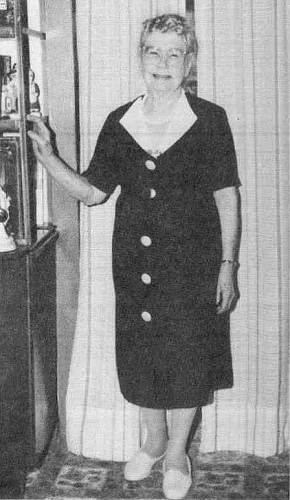
04 Ila Tucker Hill
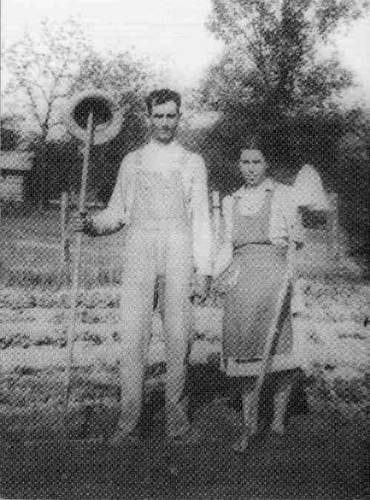
05 Bert and Ila Tucker Hill
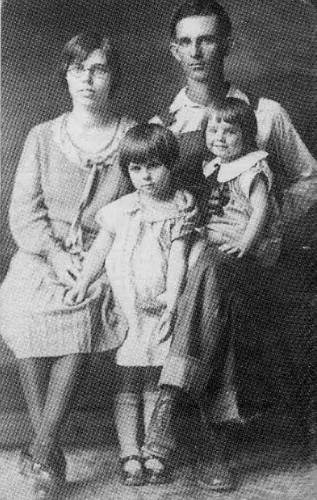
06 Ila, Bert, Alice (standing) and Dorothy (sitting) Hill
Bert and Ila (photo 07) lived
at the time on a farm near the Saline Valley Church of Christ. In those days, which were
during the depression, several miles away from Tuscumbia or Eldon, no electricity or
telephone service was available. Most people in those parts had no car; all transportation
was by horse or "Shanks Mare."
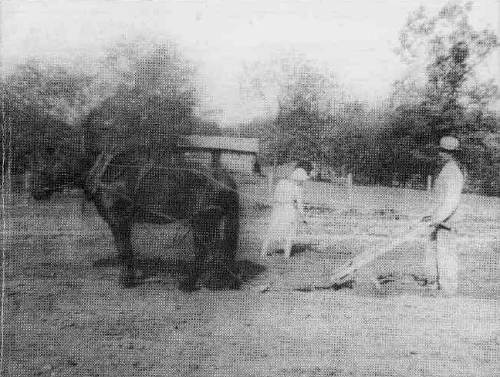
07 Bert and Ila on the farm
(By the way, the "What is it" this week is what does Shanks Mare mean?
If you don't know, you can read about it at this website: http://www.worldwidewords.org/qa/qa-sha4.htm).
Ila has a wonderful way of writing as she has the skill of creating word pictures as
well as drama in her stories. The following section is taken from her book, "Our
Memories," mentioned above, in which she describes her family's experience with what
was then as well as now a very severe and terrible disease:
"Sunday morning April 8, 1930, was very cloudy, damp
and chilly. It was Dorothy Fern's third birthday, and we had planned to go to Mother and
Dad Hill's for the day. Alice Lee and Dorothy Fern had been sick a few days before, but
seemed all right Saturday and Sunday morning. So even though it wasn't a nice day, we
thought it would be all right to take them out if they were well wrapped, so we went.
That night when we went to bed we kissed them as usual and
we all said our "Good nights". Sometimes we said that three or four times before
they could go to sleep. But that night Dorothy Fern seemed unusually wide awake and kept
saying "Goodnight Daddy, Goodnight Mother."! But she finally did go to sleep and
seemed to sleep well all night. But the next morning she wasn't the same bright eyed
little girl. We were worried but we had no idea there could be anything seriously wrong.
Then Bert discovered tiny red spots on her eye balls, and a few minutes later we knew
something was very wrong.
Bert rushed to Hall's store, more that a mile away, and
called the County Health Doctor. He came as soon as he could, and after checking her over,
he pronounced it pneumonia and left medicine for that. But we weren't satisfied, so Bert
went back to Hall's to call Dr. Berkstresser. By the time he got there she was much worse.
It didn't take him long to decide she had spinal meningitis! We knew nothing about the
disease, except that few ever survived it, or if they did, they were left a cripple for
life.
There had been several cases of it that spring and we knew
it was very contagious. But we hadn't been anywhere they could have contacted it, so the
doctor was pretty certain it was the type that sometimes followed the flu. And it usually
wasn't as contagious as the other type. So there was still some hope that it wouldn't be
so bad. What a shock that was though. The thought that we might lose one or all three of
our precious little girls! Doctor Berkstresser said there was two ways to treat it. One
was a shot which, if it helped, we'd know within twenty four hours if she would live or
die. The other was the Osteopathic treatments. That would take longer to see improvement,
but each hour she lived there was more chance of recovery than with the shots. It would be
a slight chance either way, but he would leave it up to us to decide which, and it had to
be immediately.
We didn't feel we could make such a decision, so asked him
what he would do if she was his daughter. He said the treatments, so we told him to do
that. By that time she was drawing so bad all over. Her arms and legs were in such
terrible shapes, and her little head was drawn back tight against her back. The doctor sat
on the bedside by her and gently massaged her until the spasm wore off and she could relax
a little, and maybe sleep for a short time. Then the spasms would suddenly start again and
she'd be all over the full sized bed in such agony! Words can't describe the horror of it
all.
The doctor stayed as long as he could, giving us
instructions of things we could do that might help. When he left he had very little hope
of her being alive when he came back that night, but didn't tell us that until later. But
hope began to build as each day and night passed. And he never missed coming twice each
day, usually early each morning and often late at night. But he said that he couldn't go
to bed until he came and gave Dorothy Fern her treatment.
He had many other patients, for the flu was especially bad
that year, and many developed meningitis just as Dorothy Fern had done. Then, two or three
days after she got sick, Alice Lee became very sick, with a high fever and terrible pain
in her head. Her symptoms were much different from Dorothy Fern's but Dr. Berkstresser
said it was the same disease!
When the County Health Doctor came back to check on Dorothy
and learned they had spinal meningitis, he said "I don't have a quarantine card to
put up, but you must consider your family quarantined. No one can leave here or others
come, and if they do they can't leave".
So Mother came and stayed to take care of Frieda Mae and do
the cooking. John (Bert's brother) came and went as he pleased. The County Doctor never
came back, or checked on them in any way. When Bert had told him what the girls had, he
asked what doctor made the diagnosis, and when Bert said "Dr. Berkstresser," he
said, "He's no doctor." To which Bert firmly replied, "He's the best!"
An older lady in the neighborhood, I believe a Mrs. Simpson, came offering to stay as long
as we needed her. When Bert told her we were quarantined, she said "I'm not afraid of
meningitis, "I've helped care for others with it." Bert told her we really
appreciated her offer, but couldn't let her take a chance of getting it. So she insisted
she would come back if we decided we needed her.
We really did need help, for one of us had to be with the
girls every minute, and both of us were most of the time. But if the lady had stayed we'd
have stayed with them just the same, for we couldn't think of leaving them any more than
we had to. We couldn't sleep and ate very little, even though Mother cooked the food.
Bert had to leave the house for short periods of time to do
the chores at the barn, and to carry water for house use and also for wash water. I had to
do a wash every day, no matter what the weather was like. And the doctor said I must do it
all outside to hold down the chance that Mother and John and Frieda Mae might catch the
germs.
We had set up a bed in the spare room, between the kitchen
and the room the girls were in. That was for Frieda Mae and also for Mother when she had a
chance to rest or sleep. Also, it was a place where I could lay down for a few minutes
while I let Frieda Mae nurse until she'd go to sleep. Then I'd go back to the other girls.
I didn't realize I had very little milk for her, so I'm sure she didn't have enough at any
time. But she was a very good baby and didn't cry very much. And when she did, and John
was there, he'd carry her and worry. Later Mother told me John would say "She's
starving this baby!" And I was, but didn't know it.
As I think of it now, I wonder why Dr. Berkstresser didn't
tell me to put her on the bottle. But I guess he was like us, so worried about the other
girls that he just didn't think of it. I'm quite certain that, after so long a time, we
weren't capable of realizing anything more than was absolutely necessary. And those things
we did automatically.
Alice Lee's bowels had seemed to lock, and we were afraid
to give her a strong laxative. We used enemas, and Bert went to Hall's store for castoria,
hoping that it would help. Mr. Hall was afraid to get close enough to Bert to hand it to
him, so he set the bottle on the ground and rushed back into the store. He didn't want
Bert to pay him until the girls were well, for he didn't want to touch the money that Bert
had touched! He had small children and couldn't take a chance of them getting the terrible
disease.
But no amount of the castoria helped, and her stomach grew
bigger and bigger. Even though she was laying flat on her back, her stomach was bulged way
up! She was in so much pain with both her head and stomach, and each day and night she
grew worse. Finally, in desperation, Bert's mind went back to a time when Uncle Newt had a
small calf with the same problem. He had gotten a slender twig from a certain kind of tree
that was pliable and would bend easily without breaking. Bert had watched him as he
prepared it to use as a suppository. He peeled the bark off and scraped it until it was
very smooth. Then he rubbed it well with lard and inserted it into the calf's rectum, very
gently at first, but gradually going in farther until it finally passed the blockage. The
procedure had good results, and the calf was soon well.
I have no idea how long Bert had been thinking about doing
the same for Alice Lee. For he didn't tell me until he had it ready. I know that had to be
the hardest decision he ever made in all of his life because he knew that a wrong move or
pressure could puncture her intestines. But he also knew that in another few hours Alice
Lee's intestines would burst, and then she would surely die!
So he started very gently and slowly. Soon it seemed that
the lard covered stick had reached a wall, and then gradually went around it. Then,
suddenly, her stomach began to empty out! As we watched and cried with thankful hearts, we
could see her stomach slowly sink down to almost normal. At least, in comparison to what
it had been!
When the doctor came the next morning he too shed tears of
joy as he said, "I didn't expect her to be alive today. You've done more than any
doctor would have done. You saved her life!" She was still a very sick little girl,
but from then on, over the next few days, she slowly improved.
Meanwhile, Dorothy Fern could neither hear nor speak, nor
eat nor drink. So the only liquid she had for two weeks was the little she could draw from
a clean white cloth that I dipped in a cup of water. I would sit with it poised, ready to
slip into her mouth when she happened to open it. She'd take one draw and if I didn't
remove the cloth fast, she would set her teeth on it so tight there was no way I could get
it out until she relaxed her hold on it.
Then we'd repeat the whole process until she was either too
tired to try for more or she became relaxed enough that she could go to sleep. I didn't
dare turn loose of the cloth in her mouth, for she could have sucked it down her throat
and choked on it. It was heart breaking to know how much she needed water but could only
get that little bit. Even when her eyes were open there was a dull, unknowing look in
them. So we couldn't know if she was seeing us or if she knew anything. It seemed that she
didn't. We divided our time between them, but it seemed that there was so little we could
do to make them feel better.
When the pain in Alice Lee's stomach and head eased up
enough, she asked me to read her favorite story, "Cossette", from my fourth
grade reader. It is a sad story of a small, French girl, an orphan, who had to live with a
very cruel woman who made her work very hard. This woman was the keeper of the inn in the
village. One night a kind man came who helped Cossette carry the big bucket of water the
woman had sent her to bring from a spring a distance away. The man asked why she was doing
that and when he heard her story, he offered the cruel woman a large sum of money if he
could take Cossette with him. So, even though it was a sad story, it had a happy ending.
And Alice Lee never grew tired of hearing me read it over the years, until she was old
enough to read it herself.
When she asked me to read it then, Dorothy Fern was
sleeping peacefully, so I pulled the rocker between their beds and began. I did all right
for the first few words, but it had the effect on me that it was supposed to have on
Alice. I went to sleep still reading, but she woke me saying "That's not right!"
I'd been saying something different, I never knew what it was, but she knew every word of
the story, so knew something was wrong. I tried to wake up and read it again, but kept
going to sleep! After fourteen days and nights without sleep, a quiet time like that was
better than medicine for me.
Dorothy Fern's drawing spells gradually grew less and less
until they finally ended. But we could never erase the sight of that tiny body writhing
allover the bed, her head drawn tight against her back! It was a miracle that she didn't
dehydrate, for she'd gone so long without any liquid of any kind, except the little she
could get from the wet cloth. And, of course, she also had no food. She couldn't tell me
how good that wet cloth felt in her little mouth and throat, but I knew by the way she
grabbed it and held on with her teeth. So I kept trying hoping she would soon be able to
drink enough to really help.
It seemed each day and night would never end. With all the
worries, we watched, seemingly helpless to do much to help them. But finally when the two
weeks were past, Dr. Berkstresser felt the worst was over and they would live! So he cut
his visits back to once each day or night, whichever it happened to be. Once he came so
late that, after giving Dorothy Fern her treatment and she had gone to sleep, he fell back
across the foot of her bed and went to sleep too. He looked so tired and worn. He'd
probably had little more sleep and rest than we had, for his patients were all very
special to him and their care came first.
His nurse, Laura Jordan, didn't come during all that time,
though I'm sure she would have if there hadn't been the danger of taking the disease or
carrying it to others. But the doctor had told her how few sheets we had, and of me doing
wash everyday. She told her mother who in turn told her neighbors, Dessie and Ault
Franklin, the young couple whom I worked for when their first baby was born. It so
happened that she and Bert were first cousins, so she and Mrs. Jordan's mother decided to
send sheets. That was the best present they could have sent! Such big, beautiful, white
ones! They were the best I'd ever had. Now I wouldn't have to wash every day! I sent my
thanks by the doctor, and hoped he didn't forget to tell them how much we appreciated
them. I felt I should return them when the girls were finally well. But I wasn't sure if
they'd want them, even though I'd washed them the best I could. When I asked the doctor if
he thought they'd be afraid to use them, he said he was sure they intended for me to keep
them. They weren't new but there were still lots of wear in them, so I felt guilty keeping
them. I didn't even have money to buy stamps to write them a letter of thanks. So I'm sure
they never realized how much they helped or how much we appreciated their kindness.
As soon as the girls were out of danger, Bert had to go to
bed. We never knew why, but he suddenly got so weak he couldn't be up, even around the
house. I think it may have been more than his system could take... all the worry, plus
lack of sleep and food. His family was his life, and if we had lost our little girls, I
think his grief would probably have been too much for him to bear. All the sorrow that
would have been, without the help of our family, God, and our faithful doctor! He still
came when he could, even after Bert was able to be up, and though the girls were
improving. He said it did him good to see the wonderful change in them.
The girls gradually regained their strength, though Dorothy
Fern couldn't walk, talk or hear. But the sparkle slowly began to come back into her eyes
and smile. Just watching her brought tears to our eyes, but they were tears of joy instead
of the sorrow that could have been.
She had to learn to do everything all over again. Before
her sickness began, she was as full of life and energy as any little three year old. She
loved to sing and dance around and run and play with the other children. Now in her own
quiet little world, she had to sit and play alone, and keep trying to get around.
How happy she was when she could finally stand and take a
few faltering steps, just as she did when she first learned to walk when she was a few
months old. Only this time it was harder, probably because her muscles were more stiff
from all the days and nights of spasms and suffering. But she was determined to walk, so
kept trying by holding onto everything, or leaning against anything in reach.
Then one day when Dr. Berkstresser came she walked into the
room, if one could call it walking. She was leaning against the wall and pushing herself
along by pressing her hands against the wall. It seemed to be very important to her that
Dr. Berkstresser could see her walk! I can still see her face as it lit up, and she
flashed him a happy smile that brought tears to his eyes as well as ours.
Alice Lee's sickness didn't show as much outside, but I'm
sure it weakened her system much more than we ever knew. She was never able to talk about
how she felt, but she told me in later years that she couldn't understand why she didn't
want to run and play like the other children. She just didn't have the energy. So I'm sure
it had affected her heart and other parts of her body, which has probably made the rest of
her life harder.
Mother and John had gone home. So it was up to me to take
care of Bert and the three girls, and do the chores when Oscar (brother of John and Bert)
or John weren't there. Before the girls got sick, Bert had started plowing, hoping to have
the fields ready for early com planting. Now that was an added worry, for it could be
several days or weeks before he would be able to work again.
But early one morning we could hear quite a commotion in
the field near the barn. Men were calling to each other and to their horses, and we
learned that several neighbors and relatives had come to plow and plant the fields for
Bert.
More of Uncle Tom's thoughtfulness! He had started the
suggestion to some and others had passed it on. I never knew how many came. He had told
them to bring their dinner, since I wouldn't be able to cook for them.
They came with their teams, plows, harrows, and axes, and
corn planters. So some plowed, others cut sprouts, and as soon as enough land was broken,
others started harrowing, while others started planting. They all kept working like an
assembly line and by late evening they had finished plowing the main fields, and all the
corn was planted! I'm sure they all left with a good feeling of a job well done. What a
blessing neighbors can be! Words couldn't express all the feelings of gratitude that we
felt to all those men for that long, hard day's work that they gave us from the goodness
of their hearts! But I hope they knew how much we appreciated it all. Around that time
Bert's Uncle Dan Thompson, who lived farther down the valley, came walking up from his
home for a short visit. He brought with him a half gallon syrup bucket filled with honey,
and also twenty five dollars from the Saline Valley Church of Christ. What a blessing that
was, and how we enjoyed that honey! What a treat with butter and hot biscuits!
What a wonderfully written story! Hard times were present everywhere in rural America
during those days of the Depression and the only way to get through them was family
helping family, neighbor helping neighbor, and the church family consistently remembering
those in need. Illness, injury, hard times and even tragedy could not be avoided but hope
and faith and an underlying sense of optimism about tomorrow seemed to prevail during
those times. It is of particular note that many of the children of those Miller County
people of the last century who were raised in the great depression had the grit and
determination to work and study hard to become successful in their careers whether they
remained here or went elsewhere to seek their futures. I believe the common thread was the
kind of values taught and lived in homes like that of Bert and Ila Hill.
David Hill, with whom I attended school at Tuscumbia years ago, is Ila Hill's son. He
wrote the following short biography of his mother as a preface to her books:
"Ila Tucker Hill was born on a farm near Eldon, Missouri on
July 25, 1906. She married Bert Hill on February 22, 1923, and they lived happily together
for over 60 years. Throughout her life she has been a very inquisitive and industrious
person, always striving to learn new and interesting things. From the normal skills needed
for a homemaker on a Missouri farm, to the specialized talents that are displayed in the
paintings that she has produced over the last several years. In 1993 she wrote her first
book, "Childhood Memories", and in 1994 her second book, "Our
Memories" was published. In July, 1996 she wrote "Our Little School House",
a book about the Ginger Ridge School, and "Family Memories" is her fourth book,
so far.
And, if I know her as well as I think I do, you should look for a
fifth book sometime in the next year or two!"
I asked David if he would be willing to let me put his address on this page in case one
of the readers would want to purchase one of Ila's books, and he responded as follows:
Joe,
My mother insisted that her books weren't worth more than $5.00 each, so that is what she
sold them for. I am following her lead, as getting them into circulation is more important
to me than making a profit on them. Shipping costs vary, depending on the number of books
being sent, usually from $5.00 to $10.00.
Feel free to give anyone my email address for initial contact, or,
my mailing address is:
David Hill
28149 NE 212th Ave
Battle Ground, WA 98604
Email: DavidHill@aol.com
Thanks.
The family of Ila Hill lived first on what is now called Poplar Road, which turns off
Highway 52 to the west very close to where the Skinner Tomb is located, about six miles
north of Tuscumbia. If you go a little further south on Highway 52 you will find a road
turning to the right with a road sign reading Hall's Store Road (photo 08). But look as hard as you want, you can find neither
hide nor hair of any store building because it burned years ago.
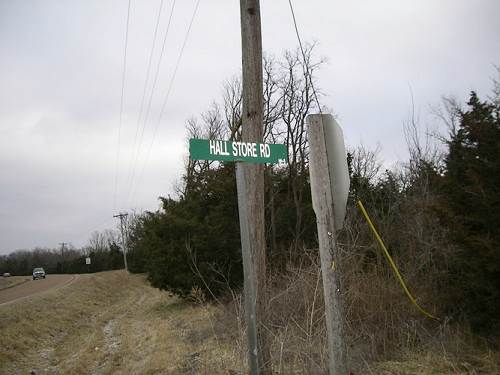
08 Hall's Store Road Sign
However, you may remember references to Hall's Store in the narrative above
written by Ila where she writes that Bert Hill, her husband, went to the "Hall's
Store" to get medicine and other needs regarding the acute illness of their daughters
with meningitis. Even though the store is gone now, it is remembered by many long time
residents of the area. I remember it myself before it burned years ago. For many years,
though, it was a landmark to which people referred as a reference point to events
occurring or which occurred in the past near the store. Perhaps one reason people referred
to the store had something to do with the fact that the highway inclines a bit as it
curves to the south causing a sometimes hazardous negotiation of the curve for those
driving too fast, especially on wet roads. My mother certainly knows this as she turned
her car over there in 1947. Years before that in 1933, my grandfather, Madison Bear, was
riding in a car in which his sister in law, Laura Abbett, also ran off the road between
Hall's Store and the Joe Heafy farm. I'm sure that many other Miller County residents can
remember someone who wrecked a car in that area.
The land where the Hall's Store was located originally was part of the James Skinner
farm (you may remember that the Progress Notes of January
21 was about the Skinner farm as remembered by Louie Lawson).
I had the opportunity to talk with Kathryn Hall Cain of Eldon, daughter of Walter and
Rachel Hall (photo 09), who were the
owners of Hall's Store.
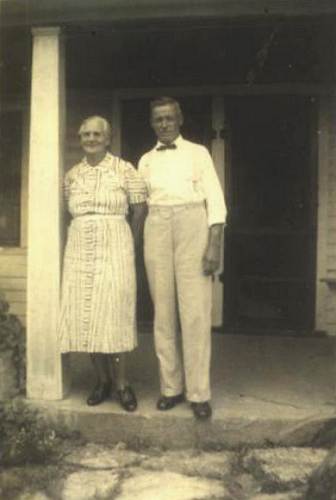
09 Rachel and Walter Hall
Kathryn says she wasn't born when her parents first arrived in Miller County many
years ago in 1913 having traveled the entire distance by covered wagon. She told me that
in 1903 in Kansas City, where the Halls lived at the time, the city had suffered severe
flooding which damaged significantly the neighborhood where her parents lived. Some years
later, John Hall, William's brother, decided that it would be best for a number of
reasons, including Walter's health, that Walter and his family should move out of the city
and live in a rural environment. Why John Hall selected Miller County isn't known but
somehow he learned of the availability of eighty acres of property originally owned by
James Skinner, which was located next to the old John Adcock (former river boat captain)
farm. So he purchased the property for his brother. An old house was already located on
the property into which Walter and his family moved. For a while Walter worked on the
railroad, and sometimes worked for John Adcock, his neighbor. But later Walter's brother,
John, suggested that he should build an extra two rooms to the house for the purpose of
opening up a small country store. So with the financial help of his brother John, Walter
was able to afford the cost of building the additions to the house and stocking the store.
While the Halls lived there they had a total of four children born to them: Bill, Kathryn,
Ina Faye and Harry. Jim was the only child born before the Halls came to Miller County,
and he decided early in life to move back to the Kansas City area (photo 10 of Hall family at Hall's Store).
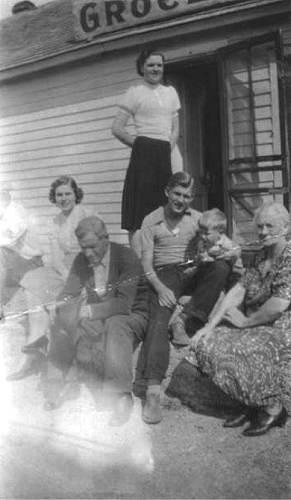
10 Ina Fay, Walter, Harry, Rachel & Kathryn (standing)
(NOTE: Harry Hall later married the daughter of Priest Allee, son of Dr. W.S.
Allee of Olean. Harry's son, William Hall, was kind enough to donate many of the records
of his great grandfather, W.S. Allee, which were used as the basis of our narrative about
Dr. Allee presented on this site January 14).
For many years the store was a stopping off place for those who wanted to buy gas as
well as serving as a small general store for people who lived in the area. Elmer Brown,
who lived a couple or three miles away from the store during his childhood in the late
twenties and thirties, wrote the following about his memories of the store:
"The Halls, Walter and Rachel, moved to Miller County from
Kansas City in roughly the same time frame (1910-1915) as my family. They had six
children, James, Ruth, Bill, Ina Faye, Kathryn and Harry. James was the only one who
wasn't born in Miller County. The Halls, with the exception of James who never stayed in
Miller County, were pretty much the same ages as my siblings so we socialized quite a bit.
I suppose it was a community effort which led to the building of a baseball field near the
intersection of what are now named Halls Store and Cat Rock Roads. I can vaguely remember
as a very small boy, attending games there when my brothers played. Frank Martin and your
uncle, Arthur Bear, played there as well and Frank has told me that Arthur had a blazing
fast ball as a pitcher but was sometimes pretty wild.
The Halls had a Model A Ford sedan (Note: memories differ as to
whether the car was a Model A or T) and Mr. Hall drove Ina Faye and Kathryn to and from
Tuscumbia to attend high school since there was no bus service. My sister, Jean was of
about that same age and mother paid Mr. Hall to transport her. She walked the mile plus
from our house to and from the highway. (Note: at times several other children rode with
the Halls' to Tuscumbia for school including Helen and Clara Heafy.)
The store was similar to many local country stores of the day when
not many people had cars. There was no electricity in the area yet so they could not stock
any perishables. They did have a limited inventory of canned goods, flour, cornmeal,
tobacco products, etc. I don't think they stocked any dry goods but I could be wrong on
that. In season they would sometimes have things like fruit, vegetables and potatoes. They
also sold kerosene and vinegar from large barrels which were located in the garage. You
took your own can or jug and had it filled there. I can remember that the vinegar was
unpasturized (I had never heard of the term then) and if you didn't use it in a timely
fashion a growth, something like a jelly fish, would develop in it. My mother called it
"mother", though I have no idea where the term originated, and would always
strain it out. It didn't seem to affect the taste or quality of the vinegar.
I just talked with my sister-in-law, Edith Brown (Bottoms) who is
the daughter of Kelly Bottoms and lived on Cat Rock Road very near Riley Bluff. She is 92
and lives in Michigan but remembers that in the spring the Halls would get in a stock of
ladies hats and display them for sale in one of the bedrooms of their living quarters. She
also remembers that they extended credit to people in the neighborhood who were short of
cash. I guess that would have applied to just about everyone at one time or another.
You're right, they did sell gasoline, Sinclair as I remember. The
pump (photo 11) had a large lever which was moved back and forth to bring the gas out of
the underground storage tank and fill the large glass tank on top. It was fed through the
hose by gravity into the tank of your car and you carefully watched numbered tabs in the
bowl so as to get the correct amount. I thought all this was pretty cool and was very
excited when I got big enough that Mr. Hall would let me pump the gas up and dispense it
into our Model A Ford.
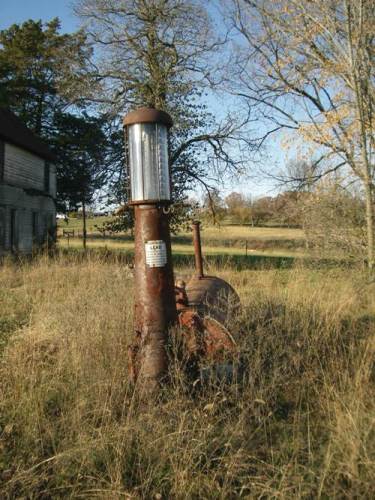
11 Old Fashioned Gas Pump
I don't remember when they closed the store but do know that
it was still operating when I was in my early teens. I just don't know if it was due to
the death of one or the other of the Halls or they could no longer make a go of it once
most everyone became mobile after WWII. The building burned but that was after I was away
from Miller County and I don't know if anyone was living in it at the time.
Don't know if this is what you are looking for or not. If you have
any questions they may trigger some other recollections.
Dub Brown
Thanks Dub.
Dub mentioned my Uncle Arthur Bear in the narrative above remarking that Arthur was a
little wild sometime with his pitching. The story is also told that Arthur was a
"little wild" whenever he tried to negotiate the curve on Hall's Store road each
day on his way to old Bagnell where he worked for his father, Madison Bear, in their
grocery store there. Mrs. Hall had a goodly number of laying hens which ran wild in the
yard and they tended to be on or next to the road every morning that Arthur came whizzing
by the house, a result of which was the occasional depletion of one or more hens from Mrs.
Hall's brood of hens. Since it was well known that Arthur recently had gotten a
"little sweet" with Lena Brown, who lived just across the river from Bagnell,
and who rode the ferry everyday over to Bagnell to see Arthur, it is understandable that
Mrs. Hall more than once was heard to exclaim that she " sure wished that young man
and woman would get married soon!!!" with the obvious understanding that she
apparently thought the result of that event might slow him down as he drove around the
curve next to her house.
Another source of information about Hall's Store was obtained by Ginnie Whitney
Duffield during an interview of Mrs. Hall in 1974 which was printed in the Autogram. I
have copied it from a clipping given me by Linda Madole Brockman, a granddaughter of Mr.
and Mrs. Hall. Linda also supplied the photos of the Hall family taken from in front of
the store sometime back in the late 1930's. Copied below is Ginnie's interview:
Hall's Store
Ginny Whitney Duffield
Miller County Autogram 1974
Since she and her family came to Eldon 61 years ago by covered
wagon, Mrs. Rachel Hall has seen many changes. For one thing, the mode of travel is much
different.
Mrs. Hall said their wagon was fixed up with a bed and carried all
the necessities for light house keeping. She said the only real problem, in her view, was
that her husband, Walter, and son, Jim, slept in the bed and she, being the smallest, drew
the wagon seat. They left Kansas March 6, 1913, and on the 13th of March stopped at Earl
Raines' father's home, she said. The next day they drove to Eldon.
"People were just wonderful to us," Mrs. Hall said. Each
evening, while on the road, they would stop at a farmhouse and ask if they could camp
nearby and most farmers were readily agreeable. Often the man of the house would bring
them milk, eggs and vegetables, Mrs. Hall said.
Hall farmed for John Adcock, a neighbor farmer, for a time; Mrs.
Hall said she can remember when the roads to the farm became so muddy that it was next to
impossible to drive over them. The family eventually obtained a car, she said, a Model T.
Ford. "It (the car) always wanted to stay in the gutter, "Mrs. Hall said,
laughing about her unsuccessful effort to learn to drive.
Wheat was a main crop in the Eldon area in the early part of the
century, Mrs. Hall remembers, Wheat fields would "just roll like water" when the
wind blew over them, she said.
Eldon has changed since she had been here, Mrs. Hall notes. Gone
ore the hitching posts in front the stores, and the Model T. Fords. Just outside Eldon
"everything was little old farms," she said. For some 25 years Mrs. Hall and her
husband operated Hall's Store, halfway between Eldon and Tuscumbia.
"We handled everything," she said. She went on to say
even though the store was small it could handle everything because there was no all that
much to handle. Today's large stores with many items are a far cry from the staples
handled back then, she said.
Her children, seven of them, all attended Harmony rural school
until they were in high school and then they went to Tuscumbia. Hall took his children to
school in Tuscumbia via Model T, and also "all the neighbors he could get,"
Seven or eight school children would climb in each morning for the ride to Tuscumbia, Mrs.
Hall said.
"He always had room for one more," she said.
Several of Mrs. Hall's children live in Eldon still. They are Mrs.
Ina Fay Madole, Mrs. Katie Cain and Mrs. Ruth Allen. Son Jim lives in Leawood, Kansas;
Bill in Creve Coeur and Harry in Texas, Johnnie is deceased.
Mrs. Hall, 95, was born in 1879 at Seymour, Indiana, and has
"never been back." Eldon, with her family and friends and where she attends
church "is a very nice place to live."
(Note: as this article was written in 1974 since that time the
only members of the original family surviving are Katie and Ruth.)
Thanks Ginnie.
A few weeks ago we were contacted by Danny Todd, son of the Reverend Robert Todd, who
was the Tuscumbia Baptist Church minister in the early 1950's. Danny and his family first
lived in the Brockman Hotel, but later moved to a house across the street from mine, so I
got to know him and his sister, Kathy, as well as his parents quite well. Danny had some
interesting experiences while living in Tuscumbia which he kindly shared with us and which
we uploaded on our church website. You can read what Danny wrote by going to the following
web address:
http://www.millercountymuseum.org/churches_todd.html
Progress continues on the renovation of the original museum building where the Anchor
Milling Company had their old hardware and feed store. Presently, we are adding interior
walls to improve the insulation for energy savings as well as building new displays which
are designed to tell a story as one walks from one display to the next. This is a feature
that is becoming more common in museums these days and we hope you will like it when we
are finished. The new addition includes a large library and research area. In this photo (photo 12) you can see Karen Smith, Nancy
Thompson, and Doris Wiggins utilizing the new shelving we purchased to improve access as
well as better protect our books and files.
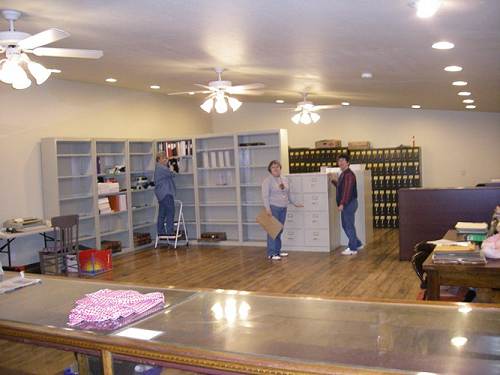
12 Karen Smith, Nancy Thompson and Doris Wiggins
As part of our efforts to improve our own Miller County museum we have been making
occasional tours of other museums in the area. Last week a number of us visited the Henry
County Museum in Clinton at the invitation of museum director, Alta Dulabay (photo 13). Alta, who was born and raised in
Henry County, was the perfect tour guide. Having been a native of the area she knew the
story behind every exhibit and the people or their descendents related to each story.
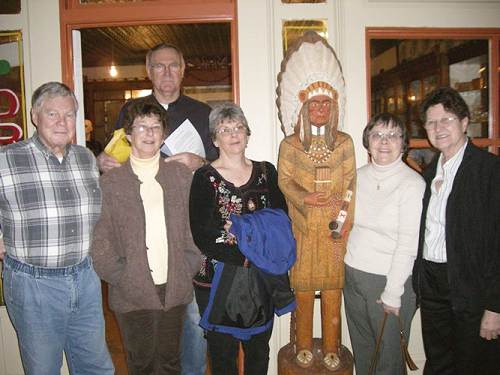
13 Jerry Thompson, Doris Wiggins, Jack Wiggins, Karen Smith, Chief Truwa, Nancy Thompson,
Alta Dulabay
This museum is a large one which has had very good community support affording
the staff many volunteers as well as excellent financial support. It is housed in three
adjacent historical buildings of Clinton right on the town square across the street from
the courthouse. The detail and authenticity of the displays and exhibits are excellent. I
would recommend to anyone that this museum should be on the "must see" list. It
would make for a very interesting and entertaining day trip. The town square is made up
almost entirely of historical buildings still in use as active businesses with the
courthouse located in the center of the square. It is a large structure with very detailed
19th century architecture and is itself worthy of a visit while in Clinton.
That’s all for this week.
| 


